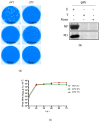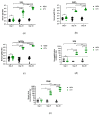A Replication-Defective Influenza Virus Vaccine Confers Complete Protection against H7N9 Viral Infection in Mice
- PMID: 32370136
- PMCID: PMC7349114
- DOI: 10.3390/vaccines8020207
A Replication-Defective Influenza Virus Vaccine Confers Complete Protection against H7N9 Viral Infection in Mice
Abstract
Avian influenza H7N9 viruses continue to pose a great threat to public health, which is evident by their high case-fatality rates. Although H7N9 was first isolated in humans in China in 2013, to date, there is no commercial vaccine available against this particular strain. Our previous studies developed a replication-defective influenza virus through mutation of the hemagglutinin (HA) cleavage site from a trypsin-sensitive to an elastase-sensitive motif. In this study, we report the development of a reassortant mutant influenza virus derived from the human isolate A/British Columbia/01/2015 (H7N9) [BC15 (H7N9)], which is the QVT virus. The HA gene of this virus possesses three mutations at the cleavage site, Lys-Gly-Arg were mutated to Gln-Thr-Val at amino acid (aa) positions 337, 338, and 339, respectively. We report this virus to rely on elastase in vitro, possess unaltered replication abilities when elastase was provided compared to the wild type virus in vitro, and to be non-virulent and replication-defective in mice. In addition, we report this virus to induce significant levels of antibodies and IFN-γ and IL-5 secreting cells, and to protect mice against a lethal challenge of the BC15 (H7N9) virus. This protection is demonstrated through the lack of body weight loss, 100% survival rate, and the prevention of BC15 (H7N9) viral replication as well as the reduction of proinflammatory cytokines induced in the mouse lung associated with the influenza disease. Therefore, these results provide strong evidence for the use of this reassortant mutant H7N9 virus as a replication-defective virus vaccine candidate against H7N9 viruses.
Keywords: elastase dependent virus; influenza A virus H7N9; replication-defective virus vaccine.
Conflict of interest statement
The authors declare no conflict of interest.
Figures








Similar articles
-
A Replication-Defective Influenza Virus Harboring H5 and H7 Hemagglutinins Provides Protection against H5N1 and H7N9 Infection in Mice.J Virol. 2021 Jan 13;95(3):e02154-20. doi: 10.1128/JVI.02154-20. Print 2021 Jan 13. J Virol. 2021. PMID: 33177192 Free PMC article.
-
A Single Amino Acid Substitution at Residue 218 of Hemagglutinin Improves the Growth of Influenza A(H7N9) Candidate Vaccine Viruses.J Virol. 2019 Sep 12;93(19):e00570-19. doi: 10.1128/JVI.00570-19. Print 2019 Oct 1. J Virol. 2019. PMID: 31270231 Free PMC article.
-
A bivalent live attenuated influenza virus vaccine protects against H1N2 and H3N2 viral infection in swine.Vet Microbiol. 2021 Feb;253:108968. doi: 10.1016/j.vetmic.2020.108968. Epub 2020 Dec 28. Vet Microbiol. 2021. PMID: 33418392
-
Research progress in human infection with avian influenza H7N9 virus.Sci China Life Sci. 2017 Dec;60(12):1299-1306. doi: 10.1007/s11427-017-9221-4. Epub 2017 Dec 1. Sci China Life Sci. 2017. PMID: 29270791 Review.
-
The Effects of Genetic Variation on H7N9 Avian Influenza Virus Pathogenicity.Viruses. 2020 Oct 28;12(11):1220. doi: 10.3390/v12111220. Viruses. 2020. PMID: 33126529 Free PMC article. Review.
Cited by
-
The African Swine Fever Virus (ASFV) Topoisomerase II as a Target for Viral Prevention and Control.Vaccines (Basel). 2020 Jun 17;8(2):312. doi: 10.3390/vaccines8020312. Vaccines (Basel). 2020. PMID: 32560397 Free PMC article. Review.
-
A Replication-Defective Influenza Virus Harboring H5 and H7 Hemagglutinins Provides Protection against H5N1 and H7N9 Infection in Mice.J Virol. 2021 Jan 13;95(3):e02154-20. doi: 10.1128/JVI.02154-20. Print 2021 Jan 13. J Virol. 2021. PMID: 33177192 Free PMC article.
References
-
- FAO H7N9 Situation Update. [(accessed on 15 March 2020)]; Available online: http://www.fao.org/ag/againfo/programmes/en/empres/h7n9/situation_update....
-
- Yang Y., Wong G., Yang L., Tan S., Li J., Bai B., Xu Z., Li H., Xu W., Zhao X., et al. Comparison between human infections caused by highly and low pathogenic H7N9 avian influenza viruses in Wave Five: Clinical and virological findings. J. Infect. 2019;78:241–248. doi: 10.1016/j.jinf.2019.01.005. - DOI - PubMed
Grants and funding
LinkOut - more resources
Full Text Sources

